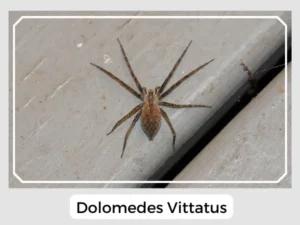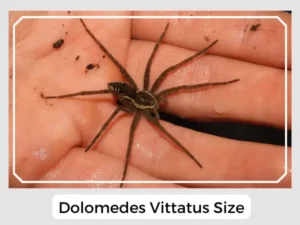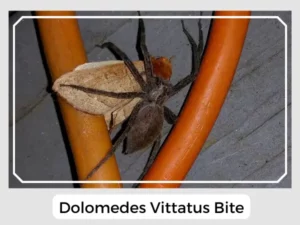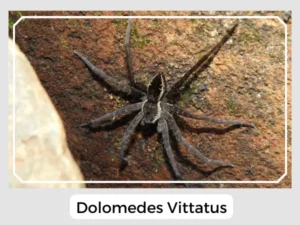The Dolomedes vittatus belongs to the nursery web spiders family. These spiders have a cool talent: they can glide across water in search of their next meal. Get ready to explore fascinating facts about them right here!

Photo Credit: Barb Sendelbach

Photo Credit: Ben Springer
Like other members of their genus, they produce a sac in which they lay their eggs.
The spiderlings resemble tiny adults. Their mother stays in the nursery with them for a few days before leaving them to fend for themselves.
They generate webs in an irregular fashion.
Yes, Dolomedes vittatus spiders are venomous, but their venom is mostly harmless to humans and is used to subdue their prey.
Yes, they can bite if threatened or provoked. However, their bite is typically not harmful to humans, causing only mild discomfort.

Photo Credit: Barb Sendelbach
Dolomedes vittatus spiders serve an important ecological function by controlling the population of aquatic insects, prawns, and even small fish. Their behavior includes a remarkable hunting technique where they utilize the surface tension of water to glide swiftly in pursuit of prey.
Natural Predator: These spiders, despite their venomous defense, are prey to birds, fish, and larger predators that share their aquatic habitat.
Prey-Predator Dynamics: The Dolomedes vittatus represents an integral part of the food web, acting as both a predator to smaller aquatic creatures and prey to larger animals. This dynamic is crucial for the balance of the ecosystems they inhabit.
Relationship with Humans: Human encounters with Dolomedes vittatus spiders are typically rare and non-threatening. While they are capable of biting, such instances are uncommon and the effects are minimal, resulting in little more than slight discomfort.

Photo Credit: Ben Springer
| Lifespan | 2 years |
| Distribution | The United States |
| Habitat | Creek, river, and stream banks |
| Diet | Aquatic insects, prawns, and fish |
In essence, the Dolomedes vittatus plays a significant role in its aquatic environment, contributing to the biodiversity and ecological stability of its habitat.
The Dolomedes vittatus belongs to the nursery web spiders family. These spiders have a cool talent: they can glide across water in search of their next meal. Get ready to explore fascinating facts about them right here!

Photo Credit: Barb Sendelbach

Photo Credit: Ben Springer
Like other members of their genus, they produce a sac in which they lay their eggs.
The spiderlings resemble tiny adults. Their mother stays in the nursery with them for a few days before leaving them to fend for themselves.
They generate webs in an irregular fashion.
Yes, Dolomedes vittatus spiders are venomous, but their venom is mostly harmless to humans and is used to subdue their prey.
Yes, they can bite if threatened or provoked. However, their bite is typically not harmful to humans, causing only mild discomfort.

Photo Credit: Barb Sendelbach
Dolomedes vittatus spiders serve an important ecological function by controlling the population of aquatic insects, prawns, and even small fish. Their behavior includes a remarkable hunting technique where they utilize the surface tension of water to glide swiftly in pursuit of prey.
Natural Predator: These spiders, despite their venomous defense, are prey to birds, fish, and larger predators that share their aquatic habitat.
Prey-Predator Dynamics: The Dolomedes vittatus represents an integral part of the food web, acting as both a predator to smaller aquatic creatures and prey to larger animals. This dynamic is crucial for the balance of the ecosystems they inhabit.
Relationship with Humans: Human encounters with Dolomedes vittatus spiders are typically rare and non-threatening. While they are capable of biting, such instances are uncommon and the effects are minimal, resulting in little more than slight discomfort.

Photo Credit: Ben Springer
| Lifespan | 2 years |
| Distribution | The United States |
| Habitat | Creek, river, and stream banks |
| Diet | Aquatic insects, prawns, and fish |
In essence, the Dolomedes vittatus plays a significant role in its aquatic environment, contributing to the biodiversity and ecological stability of its habitat.